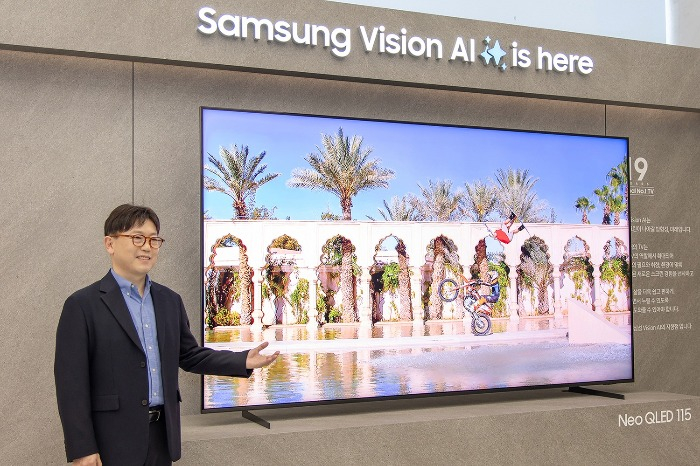Samsung unveils upgraded AI-powered OLED TVs
Samsung will also expand its mid-market TV lineup; LG Electronics posts a dip in first-quarter operating profit
By Apr 07, 2025 (Gmt+09:00)
LG Chem to sell water filter business to Glenwood PE for $692 million


KT&G eyes overseas M&A after rejecting activist fund's offer


Kyobo Life poised to buy Japan’s SBI Group-owned savings bank


StockX in merger talks with Naver’s online reseller Kream


Meritz backs half of ex-manager’s $210 mn hedge fund



Samsung Electronics Co. on Monday showcased its new lineup of organic light-emitting diode (OLED) TVs with advanced artificial intelligence features and unveiled its ambition to overtake local rival LG Electronics Inc. in South Korea's OLED TV market.
At its “Unbox & Discover 2025” event held at the Samsung Store in Gangnam, it presented its latest 14 models across six sizes – 83, 77, 65, 55,48 and 42 inches – marking its first time to offer 42-inch options.
In its third year in the OLED TV segment, Samsung is betting on a broader lineup powered by AI capabilities to boost its presence – starting with its home market.
LG is an indisputable leader in the OLED TV market, commanding more than 50% of the segment both domestically and globally.
“The premium TV market, including OLED TVs, continues to grow despite rising global economic uncertainty,” said Yong Seok-woo, president of Samsung’s visual display division. “We’ll continue to increase our share in the market.”
In the overall TV market, Samsung holds a 28.3% share as the No. 1 player in terms of 2024 sales, according to research firm Omdia. LG Electronics came next at 16.1%.

OLED TVs are gaining ground thanks to their high picture quality and brightness, despite higher price tags than traditional LCD models.
According to Omdia, the global OLED TV market grew from $7.5 billion in 2020 to $10.9 billion in 2023, underscoring rising demand for high-end displays.
“Global TV shipments will be around 40 million units this year,” said Yong. “Given that, volume growth might be limited this year, but we’ll expand our market share by focusing on premium products.”
Lim Seong Taek, executive vice president of Samsung’s domestic operations, said its OLED TVs offer the industry-leading competitiveness. He added that the company has expanded its AI-enabled TV lineup to quantum dot display (QLED) and The Frame, Samsung's lifestyle TV, beyond its ultra-large premium model: Neo QLED TV.
The lineup has expanded from 34 models across nine series last year to 61 models across 14 series for 2025. Their AI features include AI Home, AI Assistant and AI-powered viewing optimization.

MID-MARKET
To counter the rise of Chinese brands such as TCL and Hisense, Samsung is also ramping up its mid-market TV offerings.
“We plan to expand our mid-market products across all our TV lineups this year to counter the growing threat from Chinese rivals,” said Yong.
His remarks echoed those of LG Electronics CEO Cho Joo-wan.
In September last year, Cho said LG would adjust its premium-oriented strategy to expand its mass market product lineup to stay ahead of Chinese rivals.
NAVIGATING US TARIFFS
To navigate the Trump administration’s tariff hikes, Samsung will diversify its manufacturing base beyond Mexico and Vietnam, which were slapped with tariffs of 25% and 46%, respectively, said its CEO.
Most of its TVs destined for the US market are manufactured in Mexico. Samsung also operates TV plants in Brazil, Vietnam, Thailand, Indonesia, India, Egypt, South Africa, Hungary and Slovakia.
Meanwhile, LG Electronics on Monday posted 22.74 trillion won ($15.5 billion) in sales in the first three months of this year, marking its highest ever first-quarter revenue. However, its operating profit declined 5.7% on-year to 1.26 trillion won.
Write to Chae-Yeon Kim at Why29@hankyung.com
Yeonhee Kim edited this article.
-
 ElectronicsLG Display unveils industry’s brightest OLED panel for AI TVs
ElectronicsLG Display unveils industry’s brightest OLED panel for AI TVsJan 16, 2025 (Gmt+09:00)
3 Min read -
 ElectronicsLG Display to invest extra $1 bn in Vietnam OLED plant
ElectronicsLG Display to invest extra $1 bn in Vietnam OLED plantNov 17, 2024 (Gmt+09:00)
1 Min read -

-
 ElectronicsLG Electronics to boost mass market presence vs Chinese peers
ElectronicsLG Electronics to boost mass market presence vs Chinese peersSep 09, 2024 (Gmt+09:00)
3 Min read -
 ElectronicsGloves off for Samsung, LG in high-end OLED display fight
ElectronicsGloves off for Samsung, LG in high-end OLED display fightAug 29, 2024 (Gmt+09:00)
3 Min read -
 ElectronicsS.Korea relinquishes control to China in smaller OLED market
ElectronicsS.Korea relinquishes control to China in smaller OLED marketJul 26, 2024 (Gmt+09:00)
2 Min read -
 ElectronicsSamsung cements TV market lead in Q1; LG tops OLED segment
ElectronicsSamsung cements TV market lead in Q1; LG tops OLED segmentMay 21, 2024 (Gmt+09:00)
2 Min read -
 ElectronicsSamsung brings AI tech to its latest TV lineup to rival LG’s OLED TVs
ElectronicsSamsung brings AI tech to its latest TV lineup to rival LG’s OLED TVsMar 13, 2024 (Gmt+09:00)
2 Min read -

-
 ElectronicsSamsung to launch 83-inch OLED TVs equipped with LG panels in Europe
ElectronicsSamsung to launch 83-inch OLED TVs equipped with LG panels in EuropeSep 14, 2023 (Gmt+09:00)
2 Min read -
 ElectronicsLG releases world's first connection cable-free OLED TV
ElectronicsLG releases world's first connection cable-free OLED TVJul 13, 2023 (Gmt+09:00)
1 Min read -

-
 Premium TVsSamsung launches QLED TVs, aims to retain global leadership for 16th year
Premium TVsSamsung launches QLED TVs, aims to retain global leadership for 16th yearMar 03, 2021 (Gmt+09:00)
2 Min read


